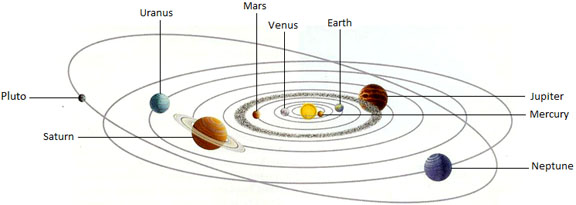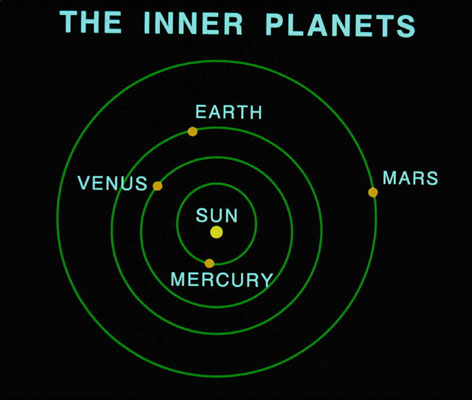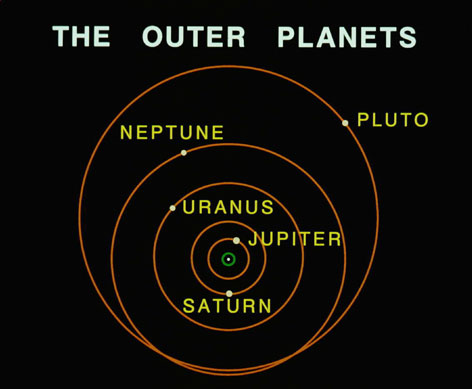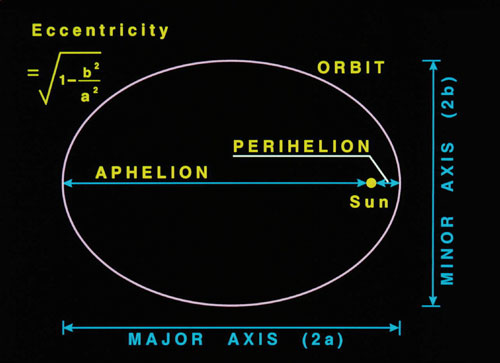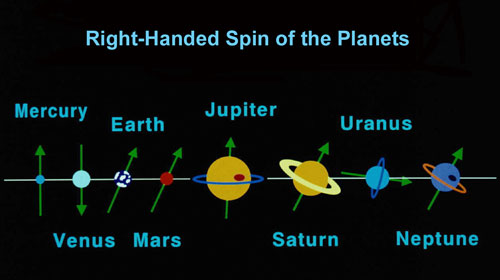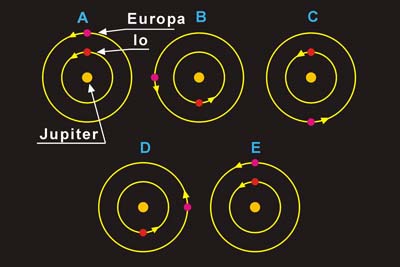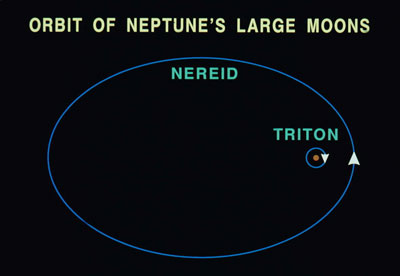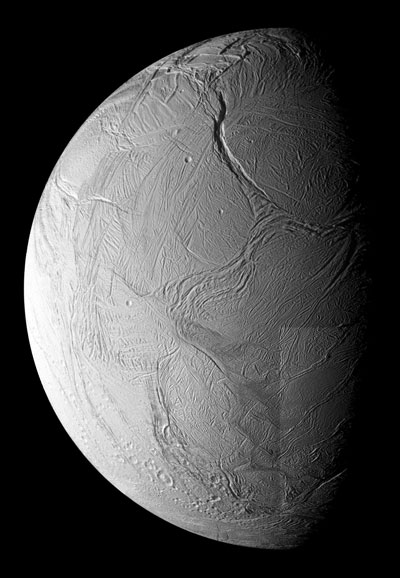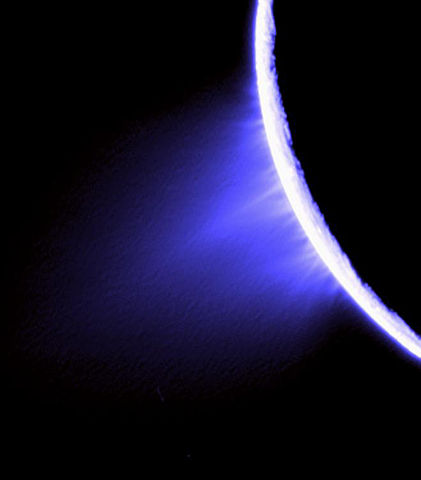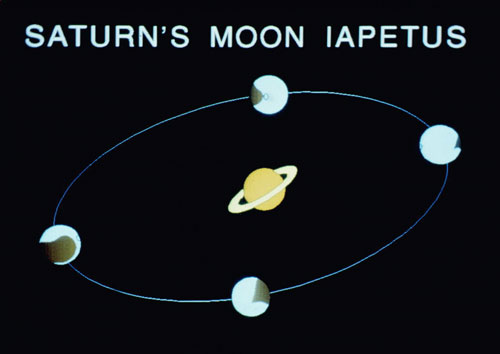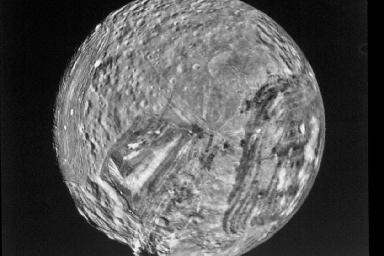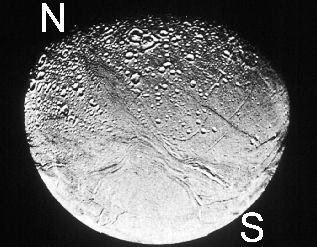Our Special Solar System(Continued)
The largest moon in the solar system is Ganymede; it is 5260 kilometers in diameter, making it even larger than the planet Mercury! Ganymede has a very large dark spot called the Galileo Regio, which is 3200 kilometers in diameter. Ganymede is also famous for its strange grooved terrain, giving it the nickname the "groovy moon." At Neptune, the moon Triton was found to have a great deal of Nitrogen and Methane ice on its surface. It has to be extremely cold for these two materials to be solid.
There is evidence of volcanism on various moons, but with different materials than the molten rock we see on Earth from volcanoes. On Europa (Jupiter) water is probably the volcanic material but at Triton (Neptune) the volcanic material would be Nitrogen probably. Volcanic material on our Moon and Mars seem to be very similar to lava and basalt rock that comes from earth's volcanoes.
The strangest moon in the solar system is Miranda, one of Uranus' moons. Miranda is a small moon and scientists didn't really want to even study it with Voyager. They wanted to get the really detailed photos of some of Uranus' larger moons. Scientists assuming evolution and an old age for things expect more interesting geology, more volcanism, and more surface features on a large moon. Small moons give off heat more rapidly than large ones. This is why Miranda was such a surprise. If it were 4.6 billion years old and formed from a collapsing cloud, it should not be so interesting.
At Miranda Voyager photographed many types of strange surface features. One of the NASA scientists said "if you can imagine taking all the bizarre geologic forms in the solar system and putting them on one object, you've got it in front of you." Miranda has a cliff face, for instance, which is nearly 10 miles high. The most famous feature is something called "the chevron" which looks like a giant white check mark! Scientists apparently have no clue how to explain it. Two well-known planetary scientists (see reference 14) recently wrote the following about this mysterious check mark: "From a distance, it looked as though some celestial giant had painted a big white check mark on its surface, as if to say, 'Here's the answer!'" It has been suggested that Miranda (which I have called the Mangled Moon or the Quilted Moon) is an object that went through a collision. The idea is that it broke apart and pulled back together and rounded itself into a sphere again. To the author, believing in a "celestial giant" seems more reasonable. But the author would call him God. There is such a variety of strange and different "worlds" in our solar system it will give scientists much to learn for many years to come.
Figure 10 - Miranda (Uranus)
Perhaps the most direct evidence of catastrophe in the Solar System, however, is in the craters. Planets and moons in all regions of the Solar System bear the marks of being heavily bombarded by meteorites. Evolutionists all agree that there was a period of heavy cratering in the past, with much more frequent impacts than today. Evolutionists believe it was due to debris leftover from the formation of the planets, which would be swept up by the planets.
Before going on, the reader should understand the difference between a meteor, a meteoroid, and a meteorite. A
meteor is an object that is falling through the atmosphere but which does not stay in tact long enough to make it to the ground. A
meteoroid is an object on its way to hitting the earth (or other planet, etc.) before it reaches the earth. So meteoroids are out in space.
Meteorites are objects that survive the trip through the atmosphere without completely "burning up," and reach the ground. Meteor showers occur at certain known times of the year because there are small objects scattered along the orbits of some asteroids and some comets. When the earth crosses one of these orbits, it sweeps up some of these objects and we see them glow as they fall through our atmosphere. What really happens when they "burn up" is that they become so hot that the solid matter in them is vaporized (turned into a gas). Then, the matter in the meteor would eventually fall to the surface as microscopic dust particles, which look like tiny balls.
Craters
Much can be learned about a planet or moon by studying its craters. Three important observations are that 1) there are large craters nearly everywhere in the Solar System, 2) there are many of them, and 3) there are sometimes more craters on one part of the surface than on another.
Considering the large craters in the Solar System let us define "large" as large compared to the size of the planet or moon they are found on. Beginning at Mercury, there is a very large impact area called the Caloris Basin which is 839 miles in diameter. Impact areas are recognized mainly by looking for circular features coupled with other surface evidence of material somehow moved or altered by the explosion. On Venus, craters are not very numerous, apparently because there is much volcanic activity which has covered or destroyed craters. Venus does have a large crater called Mead, which is 171 miles across. Mercury and our own Moon are nearly saturated with craters, at least for certain crater sizes.
On Mars, there often seems to be very ancient large craters which were filled in by lava, followed by other craters which formed later. Mars has at least two very large impact areas, called Hellas and Argyre, which are 1,200 miles and 550 miles in diameter, respectively.
(13) In some areas there may be five concentric rings of mountains. These large basins are usually quite flat in the center, with fresher craters on top of older craters. There are also craters volcanic in origin on Mars, which have different features than impact craters. Volcanism has formed a number of features on Mars that are enormous in size, such as especially the massive volcano Olympus Mons and the Valles Marineris canyon system. Valles Marineris is roughly 10 times the size of Arizona's Grand Canyon. Olympus Mons is about three times the height of Mt. Everest, the tallest mountain on earth. Almost the entire northern hemisphere of Mars has been covered with lava. The southern hemisphere, however, shows more craters than the northern hemisphere.
In the outer solar system, the moons also have lots of craters but have fewer large craters. Sometimes ice or volcanic flows have covered or destroyed them apparently. Jupiter's moon Callisto (which is nearly 3,000 miles in diameter) possesses a very large multi-ringed basin called Valhalla, which is over 1,800 miles in diameter. Valhalla is not actually a crater, but it is an impact site. At Saturn, Mimas (242 mile diameter) has the crater Herschel, which is 81 miles in diameter. Tethys at Saturn (650 miles diameter) has a large crater named Odysseus about 250 miles in diameter on one side and almost on the opposite side is a huge canyon, the Ithaca Chasma, which is 621 miles long and 62 miles wide! Clearly there have been many very powerful impacts throughout the Solar System.
Figure 11 - Saturn's Moon Enceladus
Also at Saturn, Enceladus is one of several moons whose surface is almost completely water ice. Enceladus has the brightest surface known in the solar system; its surface is very white and clean looking water ice. Enceladus and some other moons were found to be much more active geologically than expected based on the assumption of an old Solar System. (This was especially true of Miranda at Uranus, which has many bizarre geologic features.
(14)) Enceladus has many craters around its north pole but yet the remainder of its surface is largely quite smooth.
Origin of the Solar System
Today, the accepted view of the origin of the Solar System is formally called the Nebula Hypothesis. This evolutionary view begins with a cloud or nebula of gas and dust, including some elements believed to come from supernovae explosions of nearby stars. It is believed that as the material in the cloud cooled it would contract into a spinning disk. Because of turbulence in the original nebula the portion which became our Solar System was spinning in the right-handed sense. In this scenario, most of the mass and angular momentum (related to speed of rotation) would have to be in the Sun, which would then spin rapidly. But in fact, the Sun spins slowly, with a rotation period of 24 days, 16 hours. As a result, most of the angular momentum in the whole system is in the motion of the planets, exactly opposite the expected pattern. Also, the Sun itself is tilted about 7 degrees compared to the earth's orbit (the ecliptic). This tilt of the Sun does not fit the Nebula hypothesis well. Another problem is the fact that three planets spin in the backwards or retrograde sense, compared to the other planets--Venus, Uranus, and Pluto. Some have argued that collisions in the early solar system can explain these backward spins. This is not a likely explanation at all. The reason is due to what happens when an object collides with a spinning body in space. The spin rate may change some due to the collision but not the spin axis. A collision to a spinning body is likely to make the orbit change more than change the spin axis. This is because a spinning planet in space does NOT act like a top spinning on a table, since it is free to move at both ends of its spin axis.


